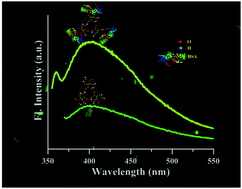Effect of bovine serum albumin on tartrate-modified manganese ferrite nano hollow spheres: spectroscopic and toxicity study†
Abstract
The emerging category of magneto-fluorescent tartrate-modified MnFe2O4 nano hollow spheres (T-MnFe2O4 NHSs) can be considered as promising candidates for biomedical applications. The interaction of bovine serum albumin (BSA) with T-MnFe2O4 NHSs has been studied using several spectroscopic techniques, which suggest that the interaction occurs by an electrostatic mechanism. Furthermore, BSA enhances the charge transfer transition from the tartrate ligand to the metal ions along with the d–d transition of Fe3+ ions on NHSs surfaces at different pH. Very strong salt bridge formation occurs between the lysine of the BSA surface and the tartrate in basic medium (pH 10), followed by the acidic (pH 3) and neutral medium (pH 7), respectively. Systematic fluorescence microscopic analysis reveals that BSA significantly enhances the contrast of T-MnFe2O4 NHSs in UV and blue light excitation because of the extended charge transfer from BSA to T-MnFe2O4 NHSs. Our report demonstrates great potential in the field of nanotechnology and biomedical applications. In vitro toxicity analysis using RAW 264.7 celline and in vivo studies on Wister rats revealed that the T-MnFe2O4 NHSs are benign. Furthermore, T-MnFe2O4 NHSs also appear to be an antimicrobial agent. Therefore, T-MnFe2O4 NHSs can be explored for future therapeutic applications.



 Please wait while we load your content...
Please wait while we load your content...